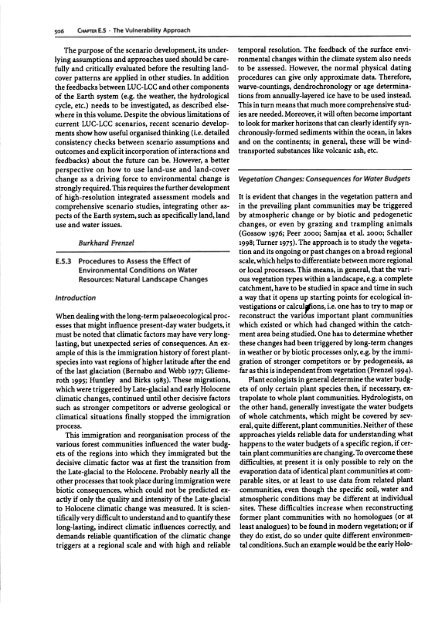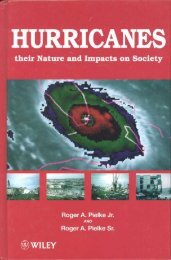How to evaluate vulnerability in changing environmental conditions
How to evaluate vulnerability in changing environmental conditions
How to evaluate vulnerability in changing environmental conditions
Create successful ePaper yourself
Turn your PDF publications into a flip-book with our unique Google optimized e-Paper software.
506<br />
CHAPTER E.5 .The Vulnerability Approach<br />
The purpose of the scenario development, its underly<strong>in</strong>g<br />
assumptions and approaches used should be carefully<br />
and critically <strong>evaluate</strong>d before the result<strong>in</strong>g landcover<br />
patterns are applied <strong>in</strong> other studies. In addition<br />
the feedbacks between LUC-LCC and other components<br />
of the Earth system (e.g. the weather, the hydrological<br />
cycle, etc.) needs <strong>to</strong> be <strong>in</strong>vestigated, as described elsewhere<br />
<strong>in</strong> this volume. Despite the obvious limitations of<br />
current LUC-LCC scenarios, recent scenario developments<br />
show how useful organised th<strong>in</strong>k<strong>in</strong>g (i.e. detailed<br />
consistency checks between scenario assumptions and<br />
outcomes and explicit <strong>in</strong>corporation of <strong>in</strong>teractions and<br />
feedbacks) about the future can be. <strong>How</strong>ever, a better<br />
perspective on how <strong>to</strong> use land-use and land-cover<br />
change as a driv<strong>in</strong>g force <strong>to</strong> <strong>environmental</strong> change is<br />
strongly required. This requires the further development<br />
of high-resolution <strong>in</strong>tegrated assessment models and<br />
comprehensive scenario studies, <strong>in</strong>tegrat<strong>in</strong>g other aspects<br />
of the Earth system, such as specifically land,land<br />
use and water issues.<br />
Burkhard Frenzel<br />
E.5.3 Procedures <strong>to</strong> Assess the Effect of<br />
Environmental Conditions on Water<br />
Resources: Natural landscape Changes<br />
Introduction<br />
When deal<strong>in</strong>g with the long-term palaeoecological processes<br />
that might <strong>in</strong>fluence present-day water budgets, it<br />
must be noted that climatic fac<strong>to</strong>rs may have very longlast<strong>in</strong>g,<br />
but unexpected series of consequences. An example<br />
of this is the immigration his<strong>to</strong>ry of forest plantspecies<br />
<strong>in</strong><strong>to</strong> vast regions of higher latitude after the end<br />
of the last glaciation (Bernabo and Webb 1977; Gliemeroth<br />
1995; Huntley and Birks 1983). These migrations,<br />
which were triggered by Late-glacial and early Holocene<br />
climatic changes, cont<strong>in</strong>ued until other decisive fac<strong>to</strong>rs<br />
such as stronger competi<strong>to</strong>rs or adverse geological or<br />
climatical situations f<strong>in</strong>ally s<strong>to</strong>pped the immigration<br />
process.<br />
This immigration and reorganisation process of the<br />
various forest communities <strong>in</strong>fluenced the water budgets<br />
of the regions <strong>in</strong><strong>to</strong> which they immigrated but the<br />
decisive climatic fac<strong>to</strong>r was at first the transition from<br />
the Late-glacial <strong>to</strong> the Holocene. probably nearly all the<br />
other processes that <strong>to</strong>ok place dur<strong>in</strong>g immigration were<br />
biotic consequences, which could not be predicted exactly<br />
if only the quality and <strong>in</strong>tensity of the Late-glacial<br />
<strong>to</strong> Holocene climatic change was measured. It is scientifically<br />
very difficult <strong>to</strong> understand and <strong>to</strong> quantify these<br />
long-last<strong>in</strong>g, <strong>in</strong>direct climatic <strong>in</strong>fluences correctly, and<br />
demands reliable quantification of the climatic change<br />
triggers at a regional scale and with high and reliable<br />
temporal resolution. The feedback of the surface <strong>environmental</strong><br />
changes with<strong>in</strong> the climate system also needs<br />
<strong>to</strong> be assessed. <strong>How</strong>ever, the normal physical dat<strong>in</strong>g<br />
procedures can give only approximate data. Therefore,<br />
warve-count<strong>in</strong>gs, dendrochronology or age determ<strong>in</strong>ations<br />
from annually-layered ice have <strong>to</strong> be used <strong>in</strong>stead.<br />
This <strong>in</strong> turn means that much more comprehensive studies<br />
are needed. Moreover, it will often become important<br />
<strong>to</strong> look for marker horizons that can clearly identify synchronously-formed<br />
sediments with<strong>in</strong> the ocean, <strong>in</strong> lakes<br />
and on the cont<strong>in</strong>ents; <strong>in</strong> general, these will be w<strong>in</strong>dtransported<br />
substances like volcanic ash, etc.<br />
Vegetation Changes: Consequences for Water Budgets<br />
It is evident that changes <strong>in</strong> the vegetation pattern and<br />
<strong>in</strong> the prevail<strong>in</strong>g plant communities may be triggered<br />
by atmospheric change or by biotic and pedogenetic<br />
changes, or even by graz<strong>in</strong>g and trampl<strong>in</strong>g animals<br />
(Gossow 1976; Peer 2000; Samjaa et al. 2000; Schaller<br />
1998; Turner 1975). The approach is <strong>to</strong> study the vegetation<br />
and its ongo<strong>in</strong>g or past changes on a broad regional<br />
scale, which helps <strong>to</strong> differentiate between more regional<br />
or local processes. This means, <strong>in</strong> general, that the various<br />
vegetation types with<strong>in</strong> a landscape, e.g. a complete<br />
catchment, have <strong>to</strong> be studied <strong>in</strong> space and time <strong>in</strong> such<br />
a way that it opens up start<strong>in</strong>g po<strong>in</strong>ts for ecological <strong>in</strong>vestigations<br />
or calcul~ions, i.e. one has <strong>to</strong> try <strong>to</strong> map or<br />
reconstruct the vari6us important plant communities<br />
which existed or which had changed with<strong>in</strong> the catchment<br />
area be<strong>in</strong>g studied. One has <strong>to</strong> determ<strong>in</strong>e whether<br />
these changes had been triggered by long-term changes<br />
<strong>in</strong> weather or by biotic processes only, e.g. by the immigration<br />
of stronger competi<strong>to</strong>rs or by pedogenesis, as<br />
far as this is <strong>in</strong>dependent from vegetation (Frenzel 1994).<br />
Plant ecologists <strong>in</strong> general determ<strong>in</strong>e the water budgets<br />
of only certa<strong>in</strong> plant species then, if necessary, extrapolate<br />
<strong>to</strong> whole plant communities. Hydrologists, on<br />
the other hand, generally <strong>in</strong>vestigate the water budgets<br />
of whole catchments, which might be covered by several,<br />
quite different, plant communities. Neither of these<br />
approaches yields reliable data for understand<strong>in</strong>g what<br />
happens <strong>to</strong> the water budgets of a specific region, if certa<strong>in</strong><br />
plant communities are chang<strong>in</strong>g. To overcome these<br />
difficulties, at present it is only possible <strong>to</strong> rely on the<br />
evaporation data of identical plant communities at comparable<br />
sites, or at least <strong>to</strong> use data from related plant<br />
communities, even though the specific soil, water and<br />
atmospheric <strong>conditions</strong> may be different at <strong>in</strong>dividual<br />
sites. These difficulties <strong>in</strong>crease when reconstruct<strong>in</strong>g<br />
former plant communities with no homologues (or at<br />
least analogues) <strong>to</strong> be found <strong>in</strong> modern vegetation; or if<br />
they do exist, do so under quite different <strong>environmental</strong><br />
<strong>conditions</strong>. Such an example would be the early Holo-














